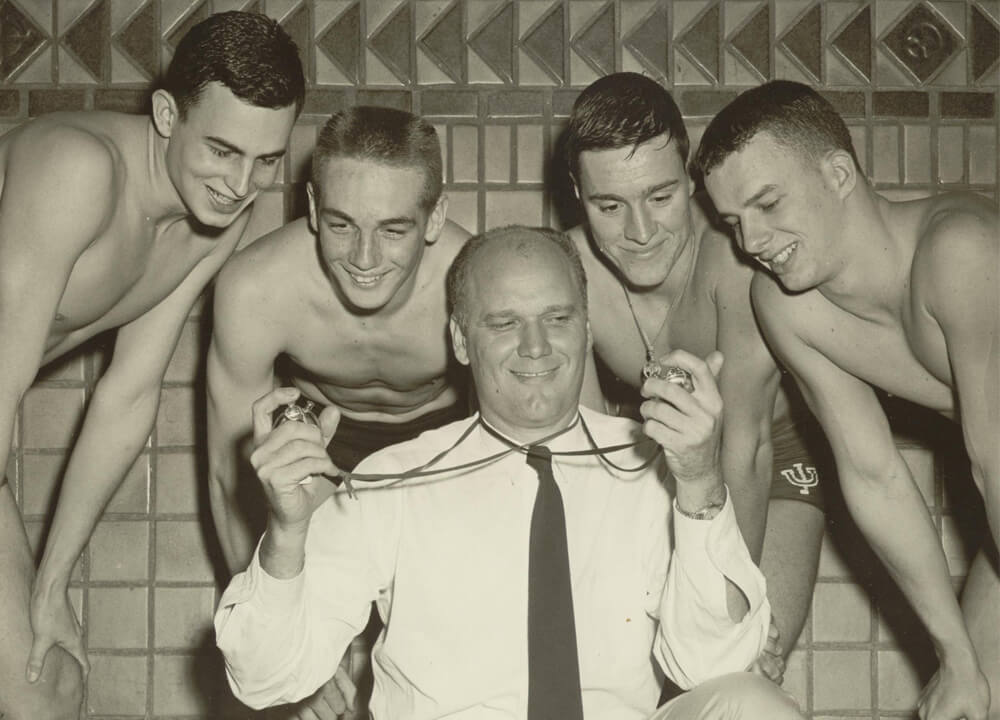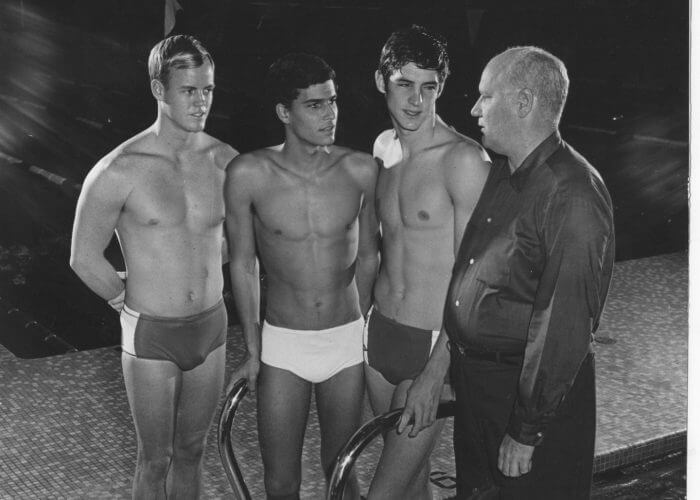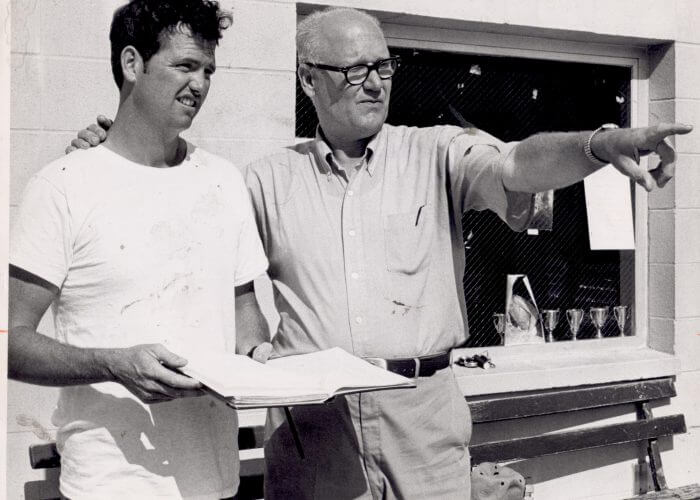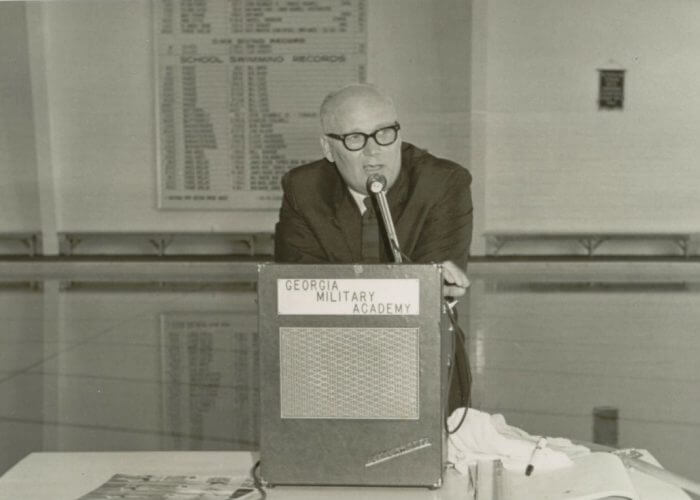The Doctor of Success: A Look at the Legendary Indiana Teams of Doc Counsilman

The Doctor of Success: A Look at the Legendary Indiana Teams of Doc Counsilman
Words were not necessary. All that was required was a glance around the natatorium. A look at the banners that celebrated past championships. A look at the honor roll of Olympians. The intensity and purpose that defined the workouts taking place in the pool. The concentration in the eyes of the coach monitoring the work that was underway.
Indiana University sits in the southern portion of the state, the city of Bloomington its home. And in the late 1960s into the early 1970s, the school was a focal point of the sport, its program a dominant presence not just on the collegiate scene, but also on the international stage.
When James “Doc” Counsilman took the reins of the Indiana program in 1957, the Big Ten Conference belonged to Michigan and Ohio State. Within a few years, though, Counsilman shifted the balance of power to the Hoosier State, and that control endured for two decades, with Indiana also emerging as a national force.
From 1961 to 1980, Counsilman led the Hoosiers to 20 consecutive Big Ten Conference crowns and Bloomington became a hub for top talent. Athlete after athlete, and team after team, passed along vast expectations in two departments. First, the Hoosiers were going to win, plain and simple. They were going to contend for championships and compete at an elite level. More, they were going to conduct themselves with class, and honor the traits of their coach – humility, dedication and loyalty.
“I don`t think there has ever been a coach in any American collegiate sport that has done more for his sport or more thoroughly dominated his sport than Doc Counsilman.”

Photo Courtesy: ISHOF Archives
The above quote was once uttered by legendary Indiana basketball coach Bob Knight, a man who shared a campus with Counsilman. While the two men were opposites – Knight’s explosiveness contrary to Counsilman’s serenity – there was an appreciation for the success each maintained. And, boy, did Counsilman excel in his profession.
Nothing matched what Indiana was able to conjure up during the height of the Counsilman era, defined as the mid-1960s into the mid-1970s.
At the 12 NCAA Championships held between 1964 and 1975, Indiana put together a sensational run that included six team titles and five runnerup finishes. During that stretch, the rivalry between Indiana and the University of Southern California was second to none – regardless of the sport. Every year in which Indiana was the second-place finisher at the NCAA Champs, USC was the victor. Meanwhile, in four of Indiana’s championships, Southern Cal was the runnerup.
What the University of Texas has done under the guidance of Eddie Reese is certainly worth mentioning in the same breath as Counsilman’s Indiana heyday. Since Reese arrived at Texas in 1979, he has led the Longhorns to 14 NCAA championships (a record) and 12 runnerup finishes. In the 41 NCAA Champs Texas has contested with Reese in command, the team has finished in the top-three on 33 occasions.
Before both Counsilman and Reese, Robert Kiphuth had his own dynasty at Yale, where he compiled a 528-12 dual-meet record and won four NCAA titles between 1918-1959. The Bulldogs added eight runnerup finishes at the NCAA Championships, and Kiphuth was known as an innovator through the implementation of interval training and dryland work that emphasized weightlifting.
No, swimming is not a contact sport like football, where players from rival teams can physically punish one another through a crushing blow in the open field. Still, the rivalry between Indiana and USC was fierce, and neither the Hoosiers nor Trojans were likely to rescue a downing foe.
“I wouldn’t say there was hatred. That might be a little too strong,” said Gary Hall Sr., a three-time Olympian who competed collegiately for Indiana. “But we didn’t like one another. That wasn’t a mystery.”

Photo Courtesy: International Swimming Hall of Fame
The truth is, Indiana could easily have captured its first NCAA team title in the early 1960s. Fueled by Hall of Famers Chet Jastremski, Mike Troy, Ted Stickles and Kevin Berry, the Hoosiers were loaded, and had little difficulty reigning atop the Big Ten Conference. However, due to infractions by the football team, all Indiana teams were barred from NCAA championship contention from 1960 to 1963.
Finally, in 1968, the breakthrough came for Counsilman’s program, as the Hoosiers raced away from their NCAA counterparts. That championship marked the first of six straight titles, a record that has not been matched. As Indiana rolled through the opposition, it did so behind rosters that were stacked with talent.
Actually, calling these Indiana squads loaded would be an understatement. A fan of the program once quipped that Counsilman went to battle with an atomic bomb, compared to the water gun of his foes. Meanwhile, experts suggested that if Indiana had faced any country in the world in a dual meet, it would have prevailed.
The biggest weapon in the Indiana arsenal was undoubtedly Mark Spitz. The 11-time Olympic medalists, who is best known for his seven gold medals at the 1972 Games in Munich, flourished for the Hoosiers from 1969-72. Although Spitz rated as the world’s premier swimmer, he was treated like any other member of the Indiana roster.
“What Doc had was this great ability to make you feel like the most important person in the pool,” Spitz said. “Everyone came away with that feeling, whether he was a Mark Spitz or a walk-on.”
Among the other standouts at Indiana during its heyday years were Hall and Charlie Hickcox. Hall was a world-record holder in multiple events and medaled in three Olympiads (1968, 1972 and 1976). As for Hickcox, he won double-gold in the 200 individual medley and 400 individual medley at the 1968 Olympics, where he also picked up a silver medal in the 100 backstroke.
Also hailing from Indiana’s most-dominant days were individual Olympic titlists Don McKenzie (100 breaststroke) and Jim Montgomery (100 freestyle), with Mike Stamm (100 backstroke/200 backstroke) and John Kinsella (1500 freestyle) capturing silver medals.
Not surprisingly, the atmosphere at the Midwestern school was intense, team members pushing one another to reach their goals and to achieve the next significant milestone within their reach. The option to coast through a workout did not exist – not with teammates, and not with Counsilman.
“When I got there, I knew the tradition was rich,” Hall said. “Everyone knew about the past and that’s why they gave themselves to the program. There was an obligation to carry on the tradition by stepping up and doing your part. We came to be part of this family and it was important to do whatever was needed to maintain a high level. Nothing less was accepted. Every day, we tried to one-up each other. We were all trying to get Doc’s attention.”

Photo Courtesy: Minor Studio
The trust the athletes had in Counsilman was immeasurable, and that faith came from two primary areas. More than anything, Counsilman’s track record spoke for itself, and his troops knew exactly what his leadership produced. As a complement, Counsilman was an innovator and unafraid to introduced new tactics and training methods.
Counsilman placed an emphasis on strength training and film analysis, and he frequently called his athletes into his office to analyze 16-milimeter film and study ways they could cut time. Counsilman also emphasized underwater filming and was known to place lights on the fingers, hands and arms of his swimmers and, with the natatorium lights shut off, use the lights to detect proper hand and arm entry into the water.
However, the Indiana program was not suffocating. Rather, it stressed accountability and taught the swimmers the importance of self-reliance and responsibility to others. This mentality was engrained in the Hoosiers and passed along from class to class.
“Great swimmers usually have an innate sense of how they function. They seem to know instinctively how hard they need to work, and when they need to ease off,” Counsilman said. “There’s no need for the slave-driver approach to coaching. By respecting the swimmer’s perceptions about his swimming, and by good communication, a coach can develop the sensitivity to understand the swimmer’s basic needs. The great coach must have two basic abilities – he must be a good organizer and a good psychologist. The good organizer will have the large team, will attract the good swimmers from other teams, and develop (Mark Spitz) and (Gary Hall) The good psychologist will be able to handle the parent problems, get along with the city council, and be able to communicate successfully with the swimmers. He will have the super teams.”
Outside of the pool, Indiana’s legendary teams were tight knit, a common gathering place the home of their coach. While Counsilman monitored his athletes’ academic progress and allowed the use of his personal office as a work or study center, his wife, Marge, played the role of team mom. Marge Counsilman often cooked meals for the Hoosiers and provided them with a comfort zone, especially those feeling homesickness.
The potential of an NCAA program, including top guns Texas and Cal-Berkeley, winning six consecutive team championships is low in the current era, due largely to greater depth from coast to coast. So, Indiana’s record is likely safe, the passing of time only adding to legend of what Counsilman constructed.
“Doc was unusual in a lot of ways compared to others I’ve known in the sport,” Hall said. “He was intelligent and had incredible personality traits. He made everyone feel special and that was a key with the superstars. He related to everyone on the team and spoke a vernacular that resonated with the guys on the team. He used his share of four-letter words and he was funny. He showed such humility and the team followed his example. It was an honor to be coached by him and to be part of that program.”



